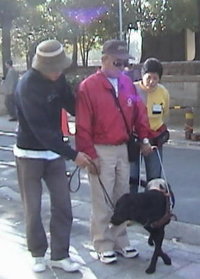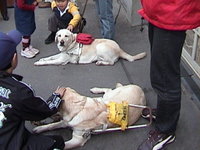 Guide dog training.
Guide dog training.
|
From Wikipedia the free encyclopedia, by MultiMedia |
 Labrador Retriever
guide dogs resting.
Labrador Retriever
guide dogs resting.
 Guide dog training.
Guide dog training.
Guide dogs are assistance dogs trained to lead blind or visually impaired people around obstacles. They are commonly but incorrectly called "Seeing Eye" dogs, since Seeing Eye is the name of only one of many guide dog training schools.
These dogs spend their early lives in foster homes where they are socialized through exposure to loving attention, and taught rudimentary skills through obedience training. Once potential guide dogs reach a certain age, they then begin their intense schooling as assistance animals while residing at a training school before being matched with compatible human partners.
These matches are cemented through a 30-day training course, wherein the human half of the team learns to control the dog and interpret its signals. Very few visually impaired people go through this training, and these candidates must already have fully developed orientation and mobility skills before they do.
Dogs are partially (red-green) color blind and so guide dogs cannot see colors the way people do, nor are they able to interpret street signs. The human half of the guide dog team does the leading, based upon skills acquired through previous mobility training.
In several countries, guide dogs are exempt from regulations against the presence of animals in places such as restaurants and public transportation.
The first guide dog training schools were established in Germany during the First World War, to enhance the mobility of returning veterans who were blinded in combat. The United States followed suit in 1929 with the Seeing Eye in Morristown, New Jersey. This school was followed, two years later, by the British Guide Dog Association.
Early on, trainers recognized which breeds produced dogs with the most appropriate temperaments for this work, so that, now, Golden Retrievers, Labradors and sometimes German Shepherd Dogs, are more likely than dogs of other breeds to be chosen, although by no means does this indicate that only these three are appropriate (for example, Boxers are also used but as they have a long adolescence they are less common.) The preferred breed is a Golden Retriever/Labrador cross because both breeds (which are in fact closely related) are known for their intelligence, responsiveness to obedience, and early maturation. There is also a recent trend of breeding a Labrador with a Poodle, to create a new hypoallergenic breed called a Labradoodle that is more suitable for those who suffer allergies. Less common breeds also trained as guide dogs include Collies, Vizlas, and Dobermans.
Guide dog puppies generally leave the breeding facility at about 8-10 weeks of age, where they go to 'puppy raisers' or 'puppy walkers.' These are families that volunteer to give training and basic commands to a potential guide dog for up to 16 months, during which time the raisers or walkers expose the puppy to as many real-world experiences as possible.
At the end of the 16-month period, the puppy is brought back to the guide dogs school. At this point, some of the schools conduct a test to analyze the dog's potential for guide dog work. If the dog passes this test, they continue on to harness training, where they learn to help a person move around safely, including such achievements as navigating curbs and avoiding overhead obstacles. The dogs may be taught additional skills, such as retrieving items for their handler.
At the end of approximately two to three months of individual training, blind students are brought to the school to work with the instructors and get a guide dog. After an additional 3 months, the team is ready to go out and be on their own.
Dogs, made by MultiMedia | Free content and software
This guide is licensed under the GNU Free Documentation License. It uses material from the Wikipedia.